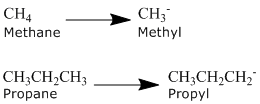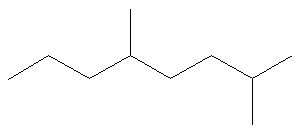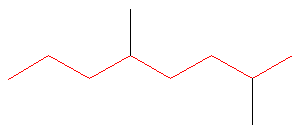|
|
ChemWiki: The Dynamic Chemistry Textbook > Organic Chemistry > Hydrocarbons > Alkanes > Nomenclature of Alkanes
Nomenclature of Alkanes
|
| Name | Molecular Formula | Condensed Structural Formula |
|---|---|---|
| Methane | CH4 | CH4 |
| Ethane | C2H6 | CH3CH3 |
| Propane | C3H8 | CH3CH2CH3 |
| Butane | C4H10 | CH3(CH2)2CH3 |
| Pentane | C5H12 | CH3(CH2)3CH3 |
| Hexane | C6H14 | CH3(CH2)4CH3 |
| Heptane | C7H16 | CH3(CH2)5CH3 |
| Octane | C8H18 | CH3(CH2)6CH3 |
| Nonane | C9H20 | CH3(CH2)7CH3 |
| Decane | C10H22 | CH3(CH2)8CH3 |
| Undecane | C11H24 | CH3(CH2)9CH3 |
| Dodecane | C12H26 | CH3(CH2)10CH3 |
| Tridecane | C13H28 | CH3(CH2)11CH3 |
| Tetradecane | C14H30 | CH3(CH2)12CH3 |
| Pentadecane | C15H32 | CH3(CH2)13CH3 |
| Hexadecane | C16H34 | CH3(CH2)14CH3 |
| Heptadecane | C17H36 | CH3(CH2)15CH3 |
| Octadecane | C18H38 | CH3(CH2)16CH3 |
| Nonadecane | C19H40 | CH3(CH2)17CH3 |
| Eicosane | C20H42 | CH3(CH2)18CH3 |
Alkyl Groups
Alkanes can be described by the general formula CnH2n+2. An alkyl group is formed by removing one hydrogen from the alkane chain, and is described by the formula CnH2n+1. The removal of this hydrogen results in a stem change from -ane to -yl. Take a look at the following examples. The same concept can be applied to any of the straight chain alkane names provided in the table above.

Using Common Names with Branched Alkanes
Some branched alkanes have common names that are still widely used today. These common names make use of prefixes such as iso-, sec-, tert-, and neo-. The prefix iso-, which stands for isomer, is commonly given to 2-methyl alkanes. In other words, if there is methyl group located on the second carbon of a carbon chain, we can use the prefix iso-. The prefix will be placed in front of the alkane name that indicates the total number of carbons.
Examples to use
isopentane which is the same as 2-methylbutane
isobutane which is the same as 2-methylpropane
To assign the prefixes sec-, which stands for secondary, and tert-, for tertiary, it is important that we first learn how to classify carbon molecules. If a carbon is attached to only one other carbon, it is called a primary carbon. If a carbon is attached to two other carbons, it is called a seconday carbon. A tertiary carbon is attached to three other carbons and last, a quaternary carbon is attached to four other carbons.
Examples to use
4-sec-butylheptane (30g)
4-tert-butyl-5-isopropylhexane (30d); if using this example, may want to move sec/tert after iso disc
The prefix neo-
Examples to use
neopentane
neoheptane
Alkoxy Groups
Alkoxides consist of an organic group bonded to a negatively charged oxygen atom. In the general form, they are written as RO-, where R represents the organic substituent. Similar to what we saw with alkyl groups above, the concept of naming alkoxides can be applied to any of the straigt chain alkanes provided in the table above.

Three Basic Principles of Naming
- Choose the longest, most substituted carbon chain containing a functional group.
- A carbon bonded to a functional group must have the lowest possible carbon number. If there are no functional groups, then any substitute present must have the lowest possible number.
- Take alphabetical order into consideration; that is, after applying the first two rules given above, make sure that your substitutes and/or functional groups are written in alphabetical order.
Numbering the Carbons
Before we begin naming alkanes, it is important to learn how to properly number the carbons in a carbon chain. Remember to follow the three basic rules in the order they are presented above.
Example

Rule #1 Choose the longest, most substituted carbon chain containing a functional group. This example does not contain any functional groups, so we only need to be concerned with choosing the longest, most substituted carbon chain. The longest carbon chain has been highlighted in red and consists of eight carbons.

Rule #2 Carbons bonded to a functional group must have the lowest possible carbon number. If there are no functional groups, then any substitute present must have the lowest possible number. Since this example does not contain any functional groups, we only need to be concerned with the two substitutes present, that is, the two methyl groups. If we begin numbering the chain from the left, the methyls would be assigned the numbers 4 and 7, respectively. If we begin numbering the chain from the right, the methyls would be assigned the numbers 2 and 5. Therefore, to satisfy the second rule, numbering begins on the right side of the carbon chain as shown below. This gives the methyl groups the lowest possible numbering.
In this example, there is no need to utilize the third rule. Since the two substitutes are identical, neither takes alphabetical precedence with respect to numbering the carbons. This concept will become more clear in the next example.
Example
Rule #1 Choose the longest, most substituted carbon chain containing a functional group. This example contains two functional groups, bromine and chlorine. The longest carbon chain has been highlighted in red and consists of seven carbons.
Rule #2 Carbons bonded to a functional group must have the lowest possible carbon number. If there are no functional groups, then any substitute present must have the lowest possible number. In this example, numbering the chain from the left or the right would satisfy this rule. If we number the chain from the left, bromine and chlorine would be assigned the second and sixth carbon positions, respectively. If we number the chain from the right, chlorine would be assigned the second position and bromine would be assigned the sixth position. In other words, whether we choose to number from the left or right, the functional groups occupy the second and sixth positions in the chain. In order to select the correct numbering scheme, we need to utilize the third rule.
Rule #3 After applying the first two rules, take alphabetical order into consideration. Alphabetically, bromine comes before chlorine. Therefore, bromine is assigned the second carbon position and chlorine is assigned the sixth carbon position.
Example
Rule #1 Choose the longest, most substituted carbon chain containing a functional group. This example contains two functional groups, bromine and chlorine, and one substitute, the methyl group. The longest carbon chain has been highlighted in red and consists of seven carbons.
Rule #2 Carbons bonded to a functional group must have the lowest possible carbon number. After taking functional groups into consideration, any substitutes present must have the lowest possible carbon number. This particular example illustrates the point of difference principle. If we number the chain from the left, bromine, the methyl group and chlorine would occupy the second, fifth and sixth positions, respectively. This is illustrated in the second drawing below. If we number the chain from the right, chlorine, the methyl group and bromine would occupy the second, third and sixth positions, respectively. This is illustrated in the first drawing below. The position of the methyl, therefore, becomes a point of difference. In the first drawing it occupies the third position. In the second drawing it occupies the fifth position. To satisfy the second rule, we want to choose the numbering scheme that provides the lowest possible numbering of this substitute. Therefore, the first of the two carbon chains shown below is correct.
Naming Alkanes
Example
Once you have determined the correct numbering of the carbons, it is often useful to make a list including functional groups, substitutes, as well as the name of the parent chain.
Parent chain: heptane 2-Chloro 3-Methyl 6-Bromo
6-bromo-2-chloro-3-methylheptane
This page viewed 15194 times
The ChemWiki has 5478 Modules.
The ChemWiki was viewed a total of 7445338 times
Powered by MindTouch Core v10





